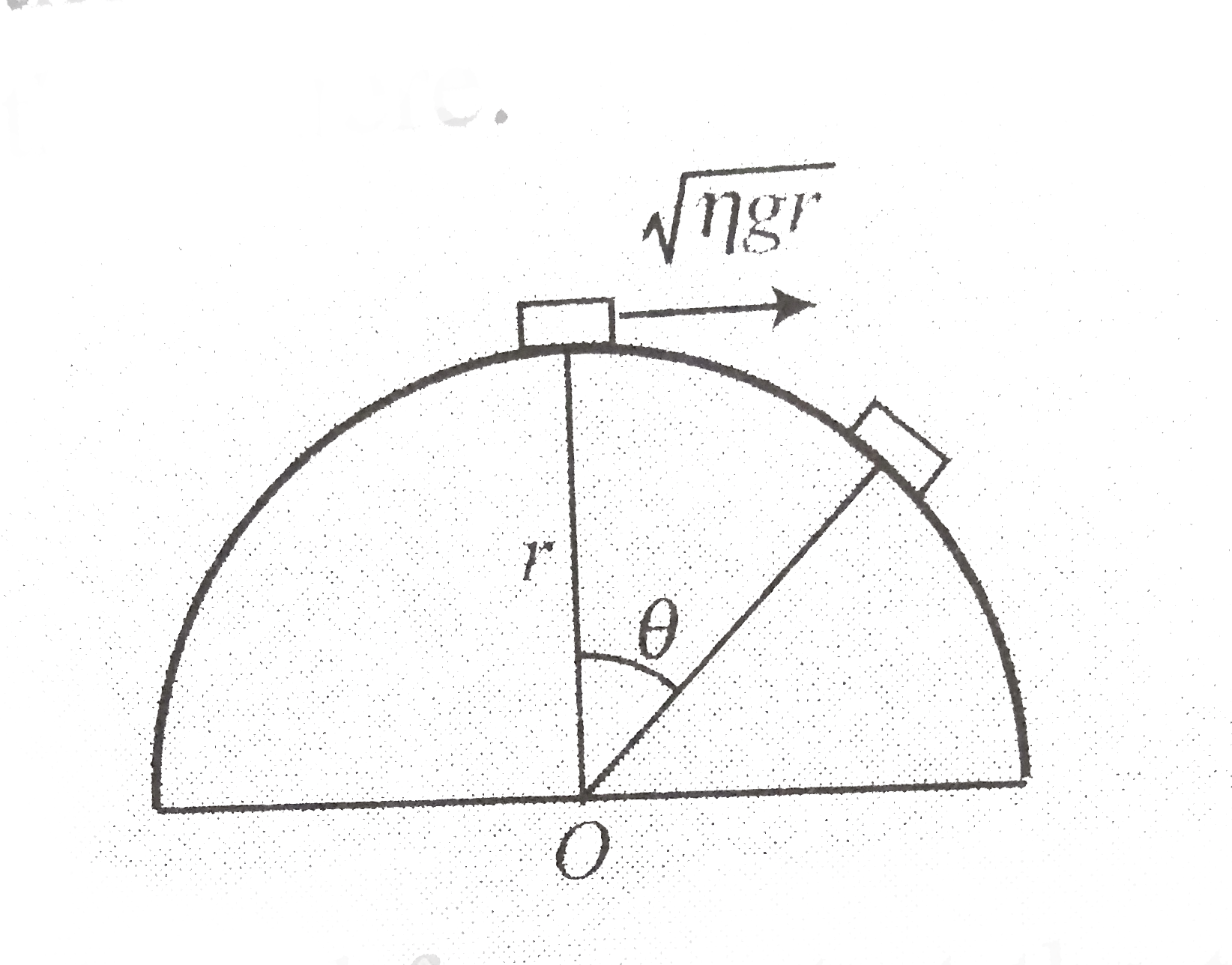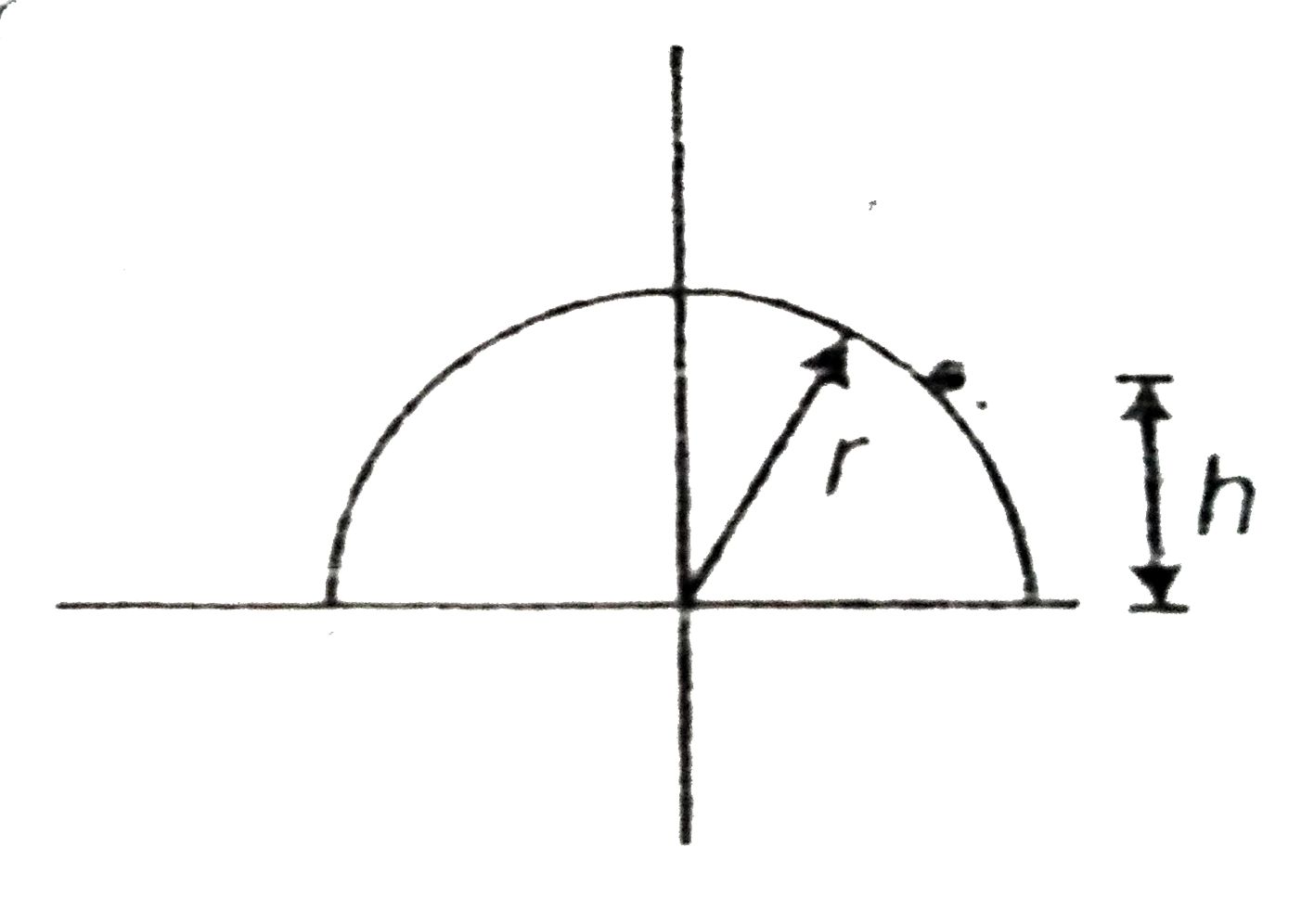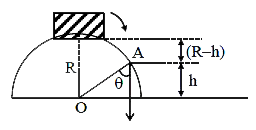A small disc is on the top of a hemisphere of radius . What is the smallest horizontal velocity that should fbe given to the disc for it to leave the hemisphere and not slide down it?[There is no friction]
The correct Answer is:B
To solve the problem of finding the smallest horizontal velocity v that should be given to the disc for it to leave the hemisphere and not slide down it, we can follow these steps:
Step 1: Understand the Forces Acting on the Disc
When the disc is at the top of the hemisphere, two forces act on it:
1. The gravitational force mg acting downwards.
2. The normal force N acting perpendicular to the surface of the hemisphere.
Step 2: Apply the Condition for Circular Motion
For the disc to maintain contact with the hemisphere while moving in a circular path, the net force acting towards the center of the hemisphere must provide the necessary centripetal force. The equation for centripetal force is given by:
N+mgcos(θ)=mv2R
where θ is the angle the radius makes with the vertical, R is the radius of the hemisphere, and v is the velocity of the disc.
Step 3: Determine the Condition for Losing Contact
The disc will lose contact with the hemisphere when the normal force N becomes zero. Therefore, we set N=0 in the centripetal force equation:
mgcos(θ)=mv2R
Step 4: Simplify the Equation
Since N=0, we can simplify the equation:
mgcos(θ)=mv2R
Dividing both sides by m (mass of the disc):
gcos(θ)=v2R
Rearranging gives us:
v2=gRcos(θ)
Step 5: Find the Minimum Velocity
The minimum velocity occurs at the point where the disc is just about to lose contact with the hemisphere. This happens when θ=0 (at the top of the hemisphere). Thus:
v2=gRcos(0)=gR
Taking the square root gives us:
v=√gR
Conclusion
The smallest horizontal velocity v that should be given to the disc for it to leave the hemisphere and not slide down it is:
v=√gR
When the disc is at the top of the hemisphere, two forces act on it:
1. The gravitational force mg acting downwards.
2. The normal force N acting perpendicular to the surface of the hemisphere.
For the disc to maintain contact with the hemisphere while moving in a circular path, the net force acting towards the center of the hemisphere must provide the necessary centripetal force. The equation for centripetal force is given by:
N+mgcos(θ)=mv2R
where θ is the angle the radius makes with the vertical, R is the radius of the hemisphere, and v is the velocity of the disc.
The disc will lose contact with the hemisphere when the normal force N becomes zero. Therefore, we set N=0 in the centripetal force equation:
mgcos(θ)=mv2R
Since N=0, we can simplify the equation:
mgcos(θ)=mv2R
Dividing both sides by m (mass of the disc):
gcos(θ)=v2R
Rearranging gives us:
v2=gRcos(θ)
The minimum velocity occurs at the point where the disc is just about to lose contact with the hemisphere. This happens when θ=0 (at the top of the hemisphere). Thus:
v2=gRcos(0)=gR
Taking the square root gives us:
v=√gR
The smallest horizontal velocity v that should be given to the disc for it to leave the hemisphere and not slide down it is:
v=√gR
Topper's Solved these Questions
Similar Questions
A very small particle rests on the top of a hemisphere of radius 20cm. Calculate the smallest horizontal velocity to be given to it if it is to leave the hemisphere without sliding down its surface, take g=9.8m/s2.
View SolutionA very small particle rests on the top of a hemisphere of radius 20 cm. Calculate the smallest horizontal velocity to be given to it if it is to leave the hemisphere without sliding down its surface. Take g=9.8ms−2.
View Solution
Knowledge Check
A partcle rests on the top of a hemisphere of radiu R. Find the smallest horizontal velocity that must be imparted to the particle if it is to leave the hemisphere without sliding down it-
A√gRB√2gRC√3gRD√5gRA partcle rests on the top of a hemisphere of radius R. Find the smallest horizontal velocity that must be imparted to the particle if it is to leave the hemisphere without sliding down :
A√gRB√2gRC√3gRD√5gRA small particle rest on the top of a hemisphere of radius 20 cm .The smallest horizontal velocity os given to it , if it is to leave the hemisphere without sliding down to its surface ,is
A0.7m/sB1.4m/sC2.8m/sD5.6m/s
A particle rests on the top of a smooth hemisphere of radius r. It is imparted a horizontal velocity of √ηgr. Find the angle made by the radius vector joining the particle with the vertical at the instant the particle losses contact with the sphere.

View SolutionA small body of mass m slides without friction from the top of a hemisphere of radius r. At what hight will the body be detached from the centre of hemisphere?

View SolutionA small block slides down from the top of hemisphere of radius R = 3 m as shown in the figure. The height 'h' at which the block will lose contact with the surface of the sphere is __________ m.
(Assume there is no friction between the block and the hemisphere)

View SolutionA particle of mass m is released from the top of a smooth hemisphere of radius R with the horizontal speed μ. Calculate the angle with verticle where it loses contact with the hemisphere.
View SolutionA body rest on the top of a hemisphere of radius R. What will be the least horizontal velocity imparted to it , if it has to leave the hemisphere without sliding down?
View Solution
